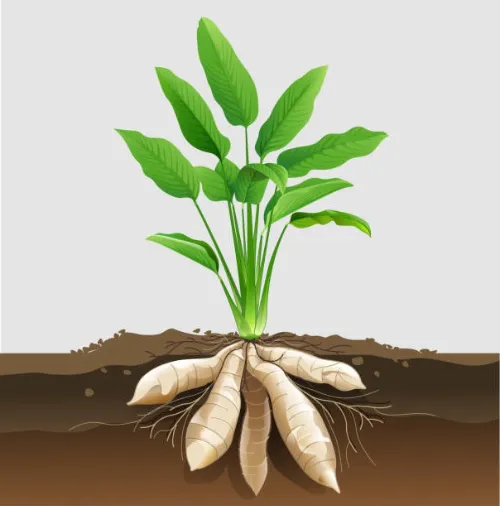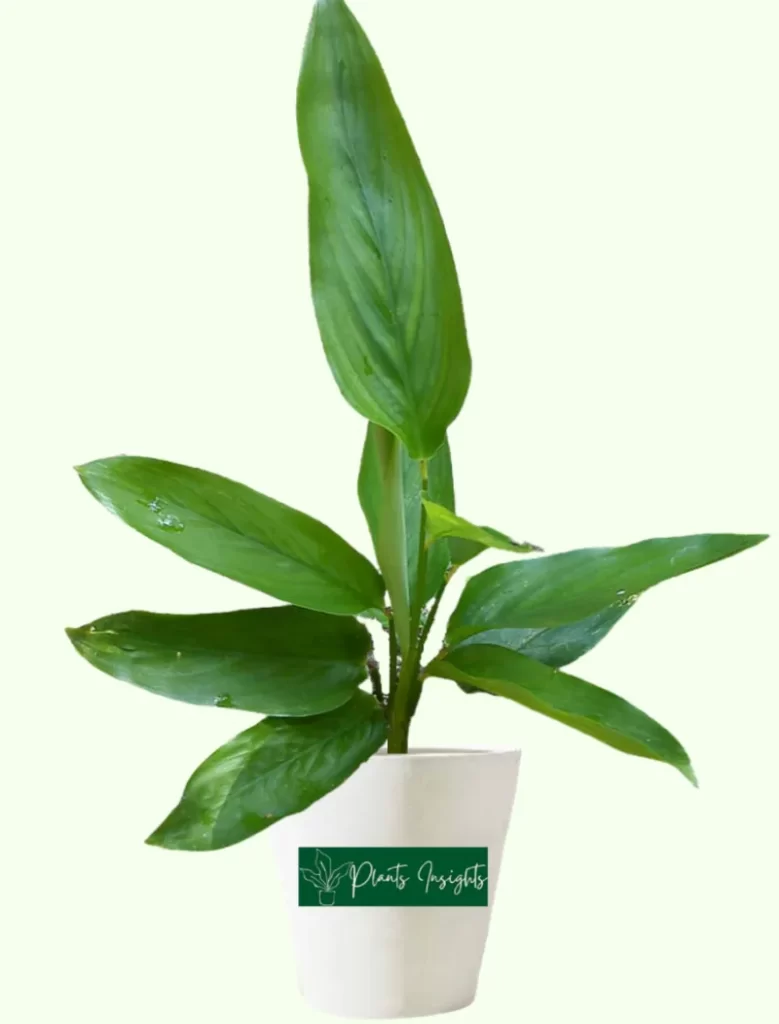Maranta Arundinacea, commonly known as the Arrowroot plant, is popular for beneficial uses of its roots in the food and medicinal industry. Arrowroot is a perennial plant that reaches up to 1.5m tall and is native to Mexico and Central America. The plant features narrow oval lush green foliage and produces tiny white flowers. It is an easy to grow plant and can be grown indoors as well as outdoors under varying climatic conditions.
Prominent Family Members: Maranta Lemon Lime, Maranta Kerchoveana, Maranta Leuconeura Red Stripe, Maranta Leuconeura Silver Band
Essential Products:
How to take care of Maranta Arrowroot?
Maranta prayers plants require the same environment that resembles the Brazilian rainforest to thrive indoors and outdoors. Furthermore, they love to stay in diffused dim light with Hot, humid surroundings. The soil must be moist all the time and have good draining quality. We will provide you with information on how to take care of all the essential factors to keep your plant green and thriving.

Bringing Maranta Arrowroot home
Excited! one more gorgeous prayer plant Maranta Arrowroot is becoming a part of indoor plant members.
Before placing a new plant indoors, a few precautionary measures shall avoid pests and diseases.
Occasionally, new plants carry pests or diseases; check the plant’s stem joints and lower side of the leaves because Pets hide below the leaves, and spider mites make webs on the joints of the stems.
Make a separate room for a newcomer in the home at least for two weeks and if it remains healthy, then introduce it to other indoor green members.

Make a separate room for a newcomer in the home at least for two weeks and if it remains healthy, then introduce it to other indoor green members.

Maranta Arundinacea’s roots usage
Commercially roots of the Maranta Arundinacea (Arrowroot prayer plant) are used to versatile the flavor of the tasteful dishes. Roots grind a soft nongranular power that contains starch and help to thicken the other flour for desserts and bread recipes, e.g., coconut, almond, or tapioca flour.

Roots of Maranta Arrowroot
Arrowroot powder is also used to treat urinary infections and smallpox sores in the medical industry.

What Light requirements for the Arrowroot Plant?
This beauty is native to Mexico, Central, and South American jungles, which have a dense vegetation population under tall trees canopies and bloom flawlessly under diffused sunlight. To flourish lively, provide the same diffused light or shaded area; however, the plant can tolerate direct sunlight also.

How much humidity for Maranta Arrowroot Plant?
Maranta Arrowroots are used to thrive in the air containing 70% humidity. In addition, more than 50 % humidity will also work well for its growth.
If your plant leaf tip and margin start turning brown, it requires more humidity. An easy way to provide more humidity is gathering all indoor plants in one place or using a homemade humidifier by putting small stones in a water-filled deep tray and placing the pot on the rocks. Make sure the pot’s base is not in contact with the water.
Note: Plant humidifiers are readily available in the market and maintain the required humidity for plants growth effectively and seamlessly.

Temperature Requirements for Maranta Arrowroot
Temperatures ranging from 68-85 °F will be perfect for Maranta Arrowroot growth; however, it cannot survive cold drafts, so keep it away from AC vents and windows.

Soil Requirement for Maranta Arrowroot
The Maranta arrowroot Prayer plant requires moist soil with well-draining properties to grow well. The ideal soil mix shall have excellent moisture-retaining, well-draining, and aeration properties.
If you plan to mix your soil for Maranta Kerchoveana, mix the following constituents in stated ratios.
Do not use regular potting soil as its draining capability is poor. Furthermore, the plant loves acidic soil in the PH range of 5.5 to 6.0.

How often should I water Maranta Arrowroot?
Native to South American jungles where annual rainfall is 59-118 inches which keeps the soil moist, Maranta Arrowroot plant growth requires the same moisture level in pot soil. To maintain soil moisture throughout the year, make a specific watering routine according to the soil moisture level.
One method is using the moisture meter and taking action according to its result or checking manually by inserting a finger deep up to two inches in potting soil to feel its moisture.
Water the Maranta Arrowroot plant with filtered or distilled water, but the best will be rainwater. Tap water contains chemicals, so avoid it.

Fertilization Requirements of Maranta Arundinacea
In the growing season, feed the plant once a month with nitrogen-based fertilizer containing phosphorus and potassium from spring to late summer. While in winter, it doesn’t require any extra nutrients.
Dilute the fertilizers according to the instruction, as the concentrated solution will burn the plant’s leaf. If any sigh of overfertilization appears, flush away the minerals from the soil by putting the pot under running water.
Note: Water your plant before fertilizing it to make it more dilute and less harmful to the plant.

Pruning /Grooming & Maintenance
Maranta Arrowroot plant requires pruning when you notice yellow-brown or damaged leaves. Furthermore, pruning also enchases the foliage growth, and plants show more freshness and greenery.
Use a clean and Pest free tool to prune your plant and give it a fresh look. Please sterilize the tools by wiping them with an alcohol swab to free them from pests and disease.

Repotting of Maranta Arundinacea
Repotting is necessary for plants growth and provides more space for roots after usually two years. Root-bound plant roots will not be able to get the required nutrients and water from the soil, and the plant will have curtailed growth.
A one or two-size bigger pot will be enough for repotting your Maranta Arrowroot plant. Fill it with moist soil, make a crater, and gently bring out the plant from the old pot. Remove the damaged and brown roots, if any, and then place the plant in the crater and cover the roots with soil. Water the Maranta Arrowroot plant and put it in a diffused light for steady growth.

Propagation of the Maranta Arundinacea
Propagation of the Maranta Arrowroot plant is done through stem nodes and roots division.
Cut the stem with at least one node, then plant it in a pot and water it. Roots will grow from the node and, once leaves development starts, transfer to a regular pot for thriving. For rapid growth, provide a greenhouse effect by placing plastic around it with holes for ventilation.
To carry out propagation by roots division, take the plant out of the pot and untangle the roots from each other. Cut a root section with a healthy stem and at least one leaf, and plant it in a smaller pot. Water the baby plant deeply and place it in a shaded spot.

Is the Maranta Arrowroot Prayer plant toxic to pets?
Research proved that Maranta Arrowroot is totally harmless to humans and animals (cats, dogs or birds, etc) even if they will ingest it.
Kids and pets can freely play around with the plants, touching them won’t cause any allergy or harm.

Pests and diseases of Maranta Arrowroot
Usually, indoor plants are not invaded by pests until a newcomer carries problems with them. Frequently inspect the leaves undersides; if webs or powdery substances are present, it confirms that spider mites or mealybugs have attacked.
Use a natural insecticide, Neem oil, on leaves after washing infected leaves. If the infection persists, then spray the recommended insecticides.
Root rot commonly occurs due to overwatering and poorly draining soil. When roots stay long in soggy soil, the fungus attacks the roots and starts rotting. Take the plant gently out of the pot and snip the diseased roots to cure the problem. Replace the wet soil with a new soil mix, and revise your watering schedule by watering when potting soil dries up to two inches.


